Vivienne Westwood
‘Britains most consistently original, outrageous and controversial designer’
was born on Tuesday 8.April 1941 as Vivienne Isabel, the first child (1944 sister Olga, 1946 brother Gordon) of Dora Ball and Gordon Swire. Their first common home was number 6 Millbrook, Glossop (Derbyshire) between Tintwistle (where Dora Ball lived) and Hollingworth (where Gorden Swire lived) near the A57, which connecting Sheffield and Manchester.
 After years in Tintwistle, in 1957 her family moved to Station Road, Harrow (NW London). ‘We had to move’ said her sister Dora, because ‘there was no work’. At one of the local dances in late 1961 Vivienne met a young man called Derek John Westwood. Vivienne was instantly smitten by the handsome Westwood, who was confident, ardent and shared her love of rock’n’roll: ‘When I met Derek he was very lively and ever such a good dancer’, she said later. Derek was working as a toolshop apprentice in the local Hoover factory, and not longer after meeting Vivienne he secured a job as a steward for British European Airways. After attending a teacher-training college Vivienne had left her typing job and became a primary-school teacher in Willesden, North London. Derek proposed to marriage and the white wedding took place on 21.July 1962 at St.John the Baptist, Greenhill. Vivienne made her own dress, which was not unusual in those days. The couple moved into 86 Station Road, 300 yards from the Swires’ sub-post office in Harrow. On 3.September 1963 her son, Benjamin Arthur Westwood was born.
After years in Tintwistle, in 1957 her family moved to Station Road, Harrow (NW London). ‘We had to move’ said her sister Dora, because ‘there was no work’. At one of the local dances in late 1961 Vivienne met a young man called Derek John Westwood. Vivienne was instantly smitten by the handsome Westwood, who was confident, ardent and shared her love of rock’n’roll: ‘When I met Derek he was very lively and ever such a good dancer’, she said later. Derek was working as a toolshop apprentice in the local Hoover factory, and not longer after meeting Vivienne he secured a job as a steward for British European Airways. After attending a teacher-training college Vivienne had left her typing job and became a primary-school teacher in Willesden, North London. Derek proposed to marriage and the white wedding took place on 21.July 1962 at St.John the Baptist, Greenhill. Vivienne made her own dress, which was not unusual in those days. The couple moved into 86 Station Road, 300 yards from the Swires’ sub-post office in Harrow. On 3.September 1963 her son, Benjamin Arthur Westwood was born.
About the marriage she later said: ‘I didn’t want to marry him actually, but he was such a sweet guy and I couldn’t give it up’. Despite Derek’s kindness and great love for his wife, she was getting bored and felt that her life was frustratingly circumscribed. Through her brother Gordon she met in 1965 Malcolm Edwards, the man who would entice her away from working-class family conformity. Despite Derek’s please, she strained to escape the marriage and finally broke away in 1965. Vivienne taking the 3-year old Ben to live in her parents flat. The couple divorced the following year. Vivienne evolved from a church-going housewife into a subversive seamstress of agitprop clothing. It was Malcolm Edwards (as McLaren was called until 1971) who channeled her latent creativity into fashion.
Her brother Gordon rented a rundown house at 31 King’s Avenue, near Clapham North Tube-Station in South London. Two fellow film students shared the house and after a few months Edwards joined them. Vivienne and her son moved in shortly afterwards. And slowly her indifference to him broke down. Edwards lectured her on the political power of art and the appeal of cult fashions. During this time, their roles were established and set for the next decade: she as the student craftsman, he the opinionated art director. Her second son Joseph Ferdinand Corre was born on 30.November 1967. The birth strained the relationship for Edwards, but it convinced Vivienne to commit herself to it.
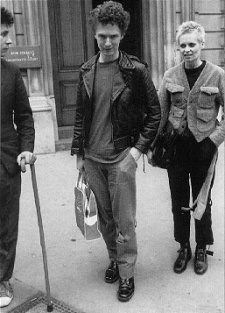 In the autumn of 1967 Edwards had enrolled at Croydon College of Art and Design to study painting, and he and Vivienne moved to a ground-floor flat in Aigburth Mansions, Hackford Road near the Kennington Oval. Six week after the birth, Vivienne, needing money, reluctantly returned to work as a teacher. One of Edwards’s friends was Jamie Reid, the son of a scottish family. Reid worked for a community press in Croydon which served black, feminist, prisoners and trade-unionist causes. At art school he stood alongside Edwards with the hope of changing the world; his companion was happy simply to play up. In 1967, radical elements in the student communities across Europe were enthralled by a new publication, Guy Debord’s ‘Society of Spectacle’. Debord was the theorist of the Situationist International. Guided by situationism, Edwards perfected his skills as the great dissembler. A friend from Harrow Art School, Fred Vermorel, who was living in Paris as a ‘hanger-on’ at the Sorbonne, corresponded with Edwards during the months preceding May’68.
In the autumn of 1967 Edwards had enrolled at Croydon College of Art and Design to study painting, and he and Vivienne moved to a ground-floor flat in Aigburth Mansions, Hackford Road near the Kennington Oval. Six week after the birth, Vivienne, needing money, reluctantly returned to work as a teacher. One of Edwards’s friends was Jamie Reid, the son of a scottish family. Reid worked for a community press in Croydon which served black, feminist, prisoners and trade-unionist causes. At art school he stood alongside Edwards with the hope of changing the world; his companion was happy simply to play up. In 1967, radical elements in the student communities across Europe were enthralled by a new publication, Guy Debord’s ‘Society of Spectacle’. Debord was the theorist of the Situationist International. Guided by situationism, Edwards perfected his skills as the great dissembler. A friend from Harrow Art School, Fred Vermorel, who was living in Paris as a ‘hanger-on’ at the Sorbonne, corresponded with Edwards during the months preceding May’68.
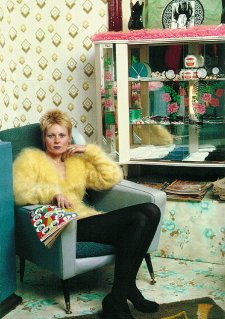 Vivienne’s last vestige of provincial conformity was eliminated in 1971 when she had her hair dramatically cut. At 29 years of age she relinquished her long hair, convinced by Edwards that having it cropped would look more sexy, cool and urban. She was the first to create the spiky, peroxide-dyed, bristling with aggression hairstyle, that was to become the hallmark of the Punks. Simon Barker, a member of the Bromley Contingent, believes that David Bowie and his wife Angie copied it, because Vivienne had the look in early 1971 before Ziggy Stardust came out. In the summer 1971 Edwards finally ended his student days by graduating. What should he do? Music was his passion, perhaps he could make a living from it, starting out by setting up a stall and selling his collection of rock’n’roll records and memorabilia. And shopkeeping was in Vivienne’s blood, from the age of 13 until she left home she had lived above her parents shop. At this time Malcolm Edwards changed his name to that of his father, McLaren, because the name Edwards was sullied with a criminal record (shoplifting and burning the greek flag at a demonstration). In October 1971, wearing his new name, a teddy boy jacket and lurex draped trousers, which Vivienne made for him, he stepped out down the Kings Road, in search of a chance encounter that would determine his and Vivienne’s future. As he passed number 430, Bradley Mendelssohn, the manager of the store ‘Paradise Garage’ spoke to McLaren ‘Where you going man? I dig the drainpipes’, referring to McLarens trousers. After McLaren explained that he was looking for a stall, Bradley suggested the back half of the shop.
Vivienne’s last vestige of provincial conformity was eliminated in 1971 when she had her hair dramatically cut. At 29 years of age she relinquished her long hair, convinced by Edwards that having it cropped would look more sexy, cool and urban. She was the first to create the spiky, peroxide-dyed, bristling with aggression hairstyle, that was to become the hallmark of the Punks. Simon Barker, a member of the Bromley Contingent, believes that David Bowie and his wife Angie copied it, because Vivienne had the look in early 1971 before Ziggy Stardust came out. In the summer 1971 Edwards finally ended his student days by graduating. What should he do? Music was his passion, perhaps he could make a living from it, starting out by setting up a stall and selling his collection of rock’n’roll records and memorabilia. And shopkeeping was in Vivienne’s blood, from the age of 13 until she left home she had lived above her parents shop. At this time Malcolm Edwards changed his name to that of his father, McLaren, because the name Edwards was sullied with a criminal record (shoplifting and burning the greek flag at a demonstration). In October 1971, wearing his new name, a teddy boy jacket and lurex draped trousers, which Vivienne made for him, he stepped out down the Kings Road, in search of a chance encounter that would determine his and Vivienne’s future. As he passed number 430, Bradley Mendelssohn, the manager of the store ‘Paradise Garage’ spoke to McLaren ‘Where you going man? I dig the drainpipes’, referring to McLarens trousers. After McLaren explained that he was looking for a stall, Bradley suggested the back half of the shop.
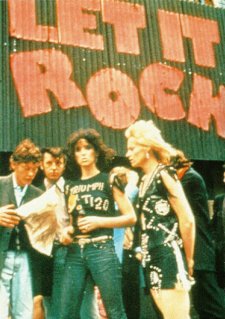
In November 1971 together with Patrick Casey they opened the shop ‘Let it Rock at Paradise Garage’ and erected a sandwich board on the pavement outside. McLaren, Casey and Vivienne (when she wasn’t teaching) scoured the the unfashionable outer London Markets for merchandise. The fifties memorabilia and the accompanying credo had little to do with contemporary fashion. But, within a few months ‘Let it Rock’ began running out of original teddy boy clothing, so McLaren convinced Vivienne, who had made her own clothes since she was a teenager, to run up copies. Left undistraced in Nightingale Lane, Vivienne sowed the seeds of her new career by repairing, altering and eventually copying of rock’n’roll clothing. She carefully and methodically unpicked and duplicated original teddy boy garments while Sid Green, an East End tailor whom she regularly consulted, made up the drape jackets in neon colours and fake fur or lurex collars chosen by her. Vivienne have been introduced to the fashion business by McLaren, but it became (in her words) ‘a baby I picked up and never put down’. Although McLaren was the frontman, Vivienne gradually became the stronger personification of ‘Let it Rock’, where she was spending an increasing amount of time. For her the shop represented a commitment to a lifestyle, where as for McLaren it was simply the stage for a lucrative pose.
Disgusted by the teds’ racist and sexist tendencies, Vivienne’s sense of justice was outraged. She and McLaren (Casey had left the business) turned away from the teddy boy image. In the spring of 1973, 430 Kings Road reopened as ‘Too Fast to Live Too Young to Die’, a tribute to James Dean’s early death. During this shop-period McLaren and Westwood began to design slogan-printed T-shirts. The subversiveness and scurrilousness of their slogans and designs attracted youthful buyers in direct proportion to the shock and offence they caused to the public at large. In August 1973, several Kings Road shops were invited to show their wares at the annual National Boutique Show in New York. There they were interviewed by Andy Warhol’s ‘Interview’ magazine. Sylvain Sylvain, guitarist of the band the New York Dolls, paid them a visit. Sylvain and Johnny Thunders had become customers of Let it Rock when they had recently visited London. The Dolls introduced Vivienne and McLaren to NY’s rock culture.
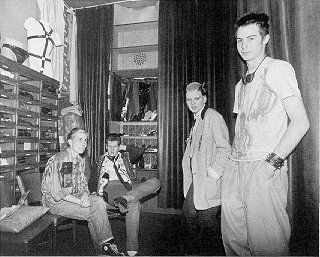 Back in London, in April 1974 they closed the shop and reopened it in the late summer under the name ‘SEX’. The gradual liberalisation of society set the scene for McLaren and Westwood, who calculated with the antagonism of the sexually-repressed English for their own products of sexual fetish. In the mid-seventies the merchandise of SEX was quite shocking. Their infamously libertarian crusade was underscored by series of explicit T-shirts. Vivienne deconstructed classic white T-shirts to its essence. She cut off the arms, ripped the shoulder seams open and knotted them back together. The reconstructed shirts were printed under McLarens instructions by his old friend Bernie Rhodes (later manager of the Clash) with images and text.
Back in London, in April 1974 they closed the shop and reopened it in the late summer under the name ‘SEX’. The gradual liberalisation of society set the scene for McLaren and Westwood, who calculated with the antagonism of the sexually-repressed English for their own products of sexual fetish. In the mid-seventies the merchandise of SEX was quite shocking. Their infamously libertarian crusade was underscored by series of explicit T-shirts. Vivienne deconstructed classic white T-shirts to its essence. She cut off the arms, ripped the shoulder seams open and knotted them back together. The reconstructed shirts were printed under McLarens instructions by his old friend Bernie Rhodes (later manager of the Clash) with images and text.
One of the earliest SEX T-shirts, devised in the autumn of 1974, was a tribal manifesto. Entitled ‘You’re gonna wake up one morning and know what side of the bed you’ve been lying on!’, they listed on the left over a hundred ‘Hates’ and on the right side their ‘Loves’:

At the end of 1974 McLaren traveled back to New York. In his six-month absence Vivienne had to establish the new identity of the shop. With the new shop assistent Jordan (Pamela Rooke), a regularly visitor since 1973, the shop became through her its specific identity. Every day she looked different, like a living art object. With her eccentric and original charakter became Jordan a cult-figure and her following flocked to the shop to admire her performance.
She was one of a handful young individuals, who wanted to be different and integrated the shops clothes into their look and inspired with their own ideas the design of the SEX-clothing. F.e. the safety pin came from Johnny Rotten via Richard Hell, who also pioneered the ripped clothing; the razor blades, bike- or lavatory- chains were introduced by punks on the street; the dog-collar by Sharon Hayman of the Bromley Contingent; the elements of militaristic dress and the extremly artificial make-up and hair by Jordan; etc.. McLaren and Vivienne used the symbols and clothing styles to create their own collection.
The punk period was a watershed in Vivienne’s personal and creative developement. In creating the Sex Pistols’ look – marketed under the label SEX and its successor Seditionaries – she evolved in a few crucial months from a seamstress, who copied past fashions and interpreted McLaren’s instructions, into a designer. ‘Up until the Sex Pistols and punk rock I’d never thought of myself as a designer’, she has said. At last her belief in her own creative abilities took root and began to flourish. She had identified her talent and was determined to leave her mark on international fashion.
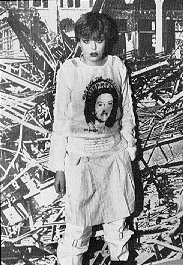
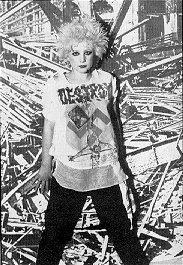 By the end of 1979, a new group of disenchanted youth emerged: the New Romantics. These urban based art students and their imitators, eschewed sexual distinction in dress, preferring to astonish and delight with lavish costume, cavalier locks and vivid facial make-up. They gathered at such London clubs as Billy’s, Blitz and Club for Heroes, ‘spinning forward in a whirl of eyeliner and ruffles. Getting reaction was the ultimate goal’, according to one of their style leaders, Boy George. Led by bands like Spandau Ballet, Visage and Adam and the Ants, the New Romantics decked themselves out in the flamboyant historical dress of Jacobites, the velvet livery of operatic valets, the dresses of Tolstoyan officers or of Shakespearean courtiers. Typically they made their own costumes or combined articles from street markets and theatrical costumiers. Responding to the new romanticism, Vivienne and McLaren came up with their own romantic character, a modern pirate. McLaren tried to push their clothing again with a band: Bow Wow Wow. ‘But history doesn’t repeat itself and when, then only as a farce’, as Karl Marx wrote.
By the end of 1979, a new group of disenchanted youth emerged: the New Romantics. These urban based art students and their imitators, eschewed sexual distinction in dress, preferring to astonish and delight with lavish costume, cavalier locks and vivid facial make-up. They gathered at such London clubs as Billy’s, Blitz and Club for Heroes, ‘spinning forward in a whirl of eyeliner and ruffles. Getting reaction was the ultimate goal’, according to one of their style leaders, Boy George. Led by bands like Spandau Ballet, Visage and Adam and the Ants, the New Romantics decked themselves out in the flamboyant historical dress of Jacobites, the velvet livery of operatic valets, the dresses of Tolstoyan officers or of Shakespearean courtiers. Typically they made their own costumes or combined articles from street markets and theatrical costumiers. Responding to the new romanticism, Vivienne and McLaren came up with their own romantic character, a modern pirate. McLaren tried to push their clothing again with a band: Bow Wow Wow. ‘But history doesn’t repeat itself and when, then only as a farce’, as Karl Marx wrote.
The same time as the Pistols dressed in Seditionaries clothes, Bow Wow Wow promoted the pirate look. The real importance of the Pirates collection was, that Vivienne became the first modern-day designer to exactly copy the cut and construction of historical dresses. ‘In the nineteenth century’, she explained in 1996, ‘Worth was passionate about past fashions, but he was content to adjust the details and adapt the proportions to contemporary patterns, rather than explore the original cut. I was a pioneer, the first to introduce that into fashion. At the same time, I was also the first to explore ethnics cuts to obtain a great number of shapes.’
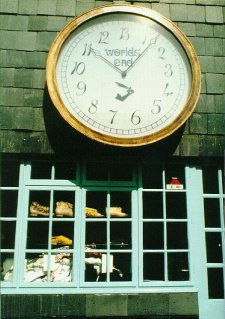 To prepare for the release of the clothes, Vivienne and McLaren decided that 430 Kings Road needed a refit. ‘I want to challenge time!’ McLaren announced and so two clocks, which ran backwards and had a thirteen-hour face, were installed; a large outside and a smaller version inside. The new shop, evoking a storm-tossed galleon (as at the end of Rock’n’Roll Swindle …), was to be called Worlds End (from that part of the Kings Road and as was written on the buses 11, 19 and 22, which were labeled with the destination ‘Chelsea, Worlds End’) and it reopened in the autumn of 1980.
To prepare for the release of the clothes, Vivienne and McLaren decided that 430 Kings Road needed a refit. ‘I want to challenge time!’ McLaren announced and so two clocks, which ran backwards and had a thirteen-hour face, were installed; a large outside and a smaller version inside. The new shop, evoking a storm-tossed galleon (as at the end of Rock’n’Roll Swindle …), was to be called Worlds End (from that part of the Kings Road and as was written on the buses 11, 19 and 22, which were labeled with the destination ‘Chelsea, Worlds End’) and it reopened in the autumn of 1980.
In March 1981 Vivienne and McLaren decided to show the Pirates collection formally on a catwalk. This step was the conscoius decision to participate in the mainstream arena. Pirates represented the turning point for Vivienne. Her official Curriculum Vitae – published in 1993 – disregarding the punk years. When quizzed about this, she explained: ‘It was in the days of Pirates that I first decided to be designer. Before that I was more interested in street culture.’ Pirates were her own ideas, whereas SEX and Seditionaries were more about McLaren and his music. The elation Vivienne felt at the success of Pirates was short-lived. McLaren left the common apartment after the show, moving in with his new girlfriend. Vivienne immersed herself in design and committing to a show every six months. Despite McLarens departure, it was not a clean break of their relation. The couple continued their partnership on a professional level for another five years. Their best work was done in partnership because, the couple faced in opposite directions. She looked back and marvelled at the shifting mannerisms and modes of sexual communication and pecularities of dress of the past. He looked to contemperary street life and the immidiate future and turned her costumes into fashion.
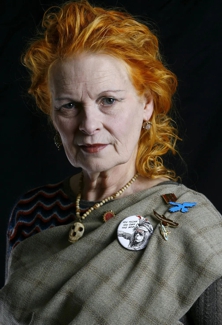
Vivienne Westwood’s career was to be built on Punk and her fashions have scandalized and fascinated the world since then. She has never lost her power to shock, and her continued innovations make her one of the most talked about fashion designers in the world.
‘I may be a rebel, but I’m not an outsider’
Vivienne Westwood 1983
Vivienne Westwood’s creative work has always been linked to attitude. Throughout her life, she has campaigned for climate protection and human rights, as well as against neo-liberal policies. She has supported protests against government austerity measures, fracking, mass tourism on cruise ships, and the protection of rainforests, as well as actions by the eXtinction Rebellion.
Despite her apparent eccentricity, Westwood had a very clear view of what was important in life – and she knew it wasn’t clothes. In recent interviews, Westwood has increasingly warned that if you keep up all the fashion fuss, you will be complicit in the end of the world. That’s why she rides a bike and is a vegetarian.

